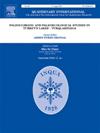Geological, paleoenvironmental, and depositional dynamics at the Middle Pleistocene Palaeoloxodon antiquus-bearing site of Campo della Spina, Central Italy
IF 1.9
3区 地球科学
Q3 GEOGRAPHY, PHYSICAL
引用次数: 0
Abstract
The paleontological site of “Campo della Spina”, in central Italy, offers valuable insights into Middle Pleistocene paleoenvironments. Excavations revealed well-preserved skeletal remains of an adult Palaeoloxodon antiquus, embedded in a sedimentary lens displaying alternating lacustrine and volcanoclastic flow characteristics. The well-preserved state of the remains suggests the elephant died at the site where it was found and was subsequent buried under conditions that facilitated preservation, while evidence of bone breakage and disarticulation indicates potential post-depositional disturbance, likely attributable to tractive water movements or debris flow events. These findings provide interdisciplinary research opportunities, shedding light on past climate dynamics and depositional processes. The site's significance lies in its contribution to understanding rapid aggradation, volcanic activity impacts, and climatic transitions during Marine Isotope Stages (MIS) 11- 9 intervals. The study highlights the importance of paleoclimate studies for informing contemporary climate change mitigation strategies. Overall, Campo della Spina offers a unique window into the interplay between climate dynamics, geological processes, and paleoenvironments, with implications for understanding past environmental changes and informing future conservation efforts.
意大利中部Campo della Spina中更新世古旧齿遗址的地质、古环境和沉积动力学
意大利中部“Campo della Spina”的古生物遗址为研究中更新世古环境提供了宝贵的见解。挖掘发现了一个保存完好的成年古绿齿龙的骨骼遗骸,嵌入在沉积透镜体中,显示出湖泊和火山碎屑流交替的特征。这具保存完好的遗骸表明,这头大象死于发现地点,随后被埋葬在有利于保存的条件下,而骨头断裂和关节脱落的证据表明,可能存在沉积后的扰动,可能是由于水流的牵引运动或泥石流事件。这些发现提供了跨学科的研究机会,揭示了过去的气候动力学和沉积过程。该遗址的意义在于它有助于理解海洋同位素阶段(MIS) 11- 9期间的快速沉积、火山活动影响和气候转变。该研究强调了古气候研究为当代气候变化减缓战略提供信息的重要性。总的来说,Campo della Spina为了解气候动力学、地质过程和古环境之间的相互作用提供了一个独特的窗口,对理解过去的环境变化和为未来的保护工作提供信息具有重要意义。
本文章由计算机程序翻译,如有差异,请以英文原文为准。
求助全文
约1分钟内获得全文
求助全文
来源期刊

Quaternary International
地学-地球科学综合
CiteScore
5.60
自引率
4.50%
发文量
336
审稿时长
3 months
期刊介绍:
Quaternary International is the official journal of the International Union for Quaternary Research. The objectives are to publish a high quality scientific journal under the auspices of the premier Quaternary association that reflects the interdisciplinary nature of INQUA and records recent advances in Quaternary science that appeal to a wide audience.
This series will encompass all the full spectrum of the physical and natural sciences that are commonly employed in solving Quaternary problems. The policy is to publish peer refereed collected research papers from symposia, workshops and meetings sponsored by INQUA. In addition, other organizations may request publication of their collected works pertaining to the Quaternary.
 求助内容:
求助内容: 应助结果提醒方式:
应助结果提醒方式:


